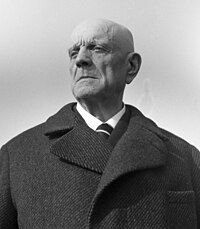
Back سمفونية رقم 8 (جان سيبيليوس) Arabic السيمفونيه رقم 8 (جان سيبيليوس) ARZ Simfonia núm. 8 (Sibelius) Catalan Συμφωνία Νο. 8 (Σιμπέλιους) Greek Sinfonía n.º 8 (Sibelius) Spanish Sinfonia nro 8 (Sibelius) Finnish Symphonie no 8 de Sibelius French Sinfonía núm. 8 (Sibelius) Galician Sinfonia n. 8 (Sibelius) Italian 交響曲第8番 (シベリウス) Japanese
| Symphony No. 8 | |
|---|---|
| by Jean Sibelius | |
 The composer (c. 1940–1945) | |
| Catalogue | JS 190 |
| Composed | mid-1920s—c. 1938 (abandoned, likely destroyed) |
The Symphony No. 8, JS 190, was the final major compositional project of the Finnish composer Jean Sibelius, occupying him intermittently from the mid-1920s until around 1938, though he never published it. During this time Sibelius was at the peak of his fame, a national figure in his native Finland and a composer of international stature. A fair copy of at least the first movement was made, but how much of the Eighth Symphony was completed is unknown. Sibelius repeatedly refused to release it for performance, though he continued to assert that he was working on it even after he had, according to later reports from his family, burned the score and associated material, probably in 1945.
Much of Sibelius's reputation, during his lifetime and subsequently, derived from his work as a symphonist. His Seventh Symphony of 1924 has been widely recognised as a landmark in the development of symphonic form, and at the time there was no reason to suppose that the flow of innovative orchestral works would not continue. However, after the symphonic poem Tapiola, completed in 1926, his output was confined to relatively minor pieces and revisions to earlier works. During the 1930s the Eighth Symphony's premiere was promised to Serge Koussevitzky and the Boston Symphony Orchestra on several occasions, but as each scheduled date approached Sibelius demurred, claiming that the work was not ready for performance. Similar promises made to the British conductor Basil Cameron and to the Finnish Georg Schnéevoigt likewise proved illusory. It is thought that Sibelius's perfectionism and exalted reputation prevented him ever completing the symphony to his satisfaction; he wanted it to be even better than his Seventh.
After Sibelius's death in 1957, news of the Eighth Symphony's destruction was made public, and it was assumed that the work had disappeared forever. But in the 1990s, when the composer's many notebooks and sketches were being catalogued, scholars first raised the possibility that fragments of the music for the lost symphony might have survived. Since then, several short manuscript sketches have been tentatively identified with the Eighth, three of which (comprising less than three minutes of music) were recorded by the Helsinki Philharmonic Orchestra in 2011. While a few musicologists have speculated that, if further fragments can be identified, it may be possible to reconstruct the entire work, others have suggested that this is unlikely given the ambiguity of the extant material. The propriety of publicly performing music that Sibelius himself had rejected has also been questioned.